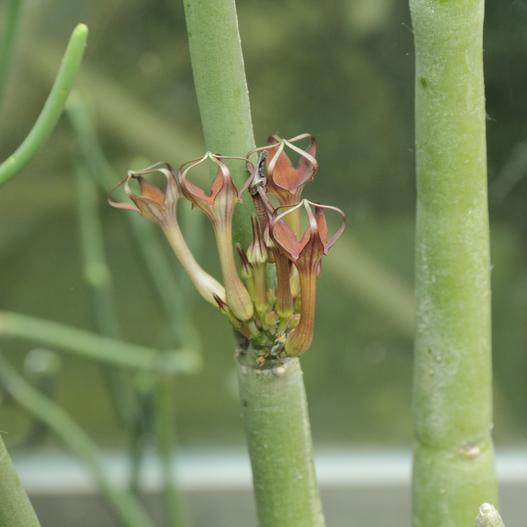Canary Island Ceropegia
(Ceropegia fusca)
Canary Island Ceropegia (Ceropegia fusca)
/
/

C T Johansson
CC BY-SA 3.0
Image By:
C T Johansson
Recorded By:
Copyright:
CC BY-SA 3.0
Copyright Notice:
Photo by: C T Johansson | License Type: CC BY-SA 3.0 | License URL: https://creativecommons.org/licenses/by-sa/3.0 | Uploader: Christer T Johansson | Publisher: Wikipedia Commons

























Estimated Native Range
Summary
Ceropegia fusca, commonly known as Canary Island Ceropegia, is a perennial succulent native to arid and semi-arid regions of the Canary Islands. It is well-adapted to its native volcanic soils and is often found in rocky areas and cliffs, where it can withstand the harsh, dry conditions. This plant typically forms erect, woody stems that can reach up to 1.5 meters in height. The leaves are deciduous, arranged in opposite pairs, and each leaf is narrow and about 5 cm long. Ceropegia fusca is notable for its unusual flowers, which are produced in clusters of two to five in the leaf axils. The flowers are tubular, reddish-brown, and have five narrow lobes that are joined at the tip, creating a striking appearance. The flowering season extends from spring to summer, and the flowers are particularly adapted for pollination by flies. The fruit consists of a pair of large capsules, each up to 10 cm long.
Canary Island Ceropegia is valued for its unique flowers and architectural form, making it a popular choice for dry and drought-tolerant gardens, as well as for rockeries and succulent collections. It is also suitable for container cultivation. In cultivation, it thrives in full sun or part shade, requiring low to medium amounts of water and well-drained soils. While it is generally easy to maintain, it can be susceptible to root rot if overwatered or if the soil does not drain sufficiently. It is not known to be invasive when grown outside its native range, but as with all non-native plants, care should be taken to prevent unintended spread.CC BY-SA 4.0
Canary Island Ceropegia is valued for its unique flowers and architectural form, making it a popular choice for dry and drought-tolerant gardens, as well as for rockeries and succulent collections. It is also suitable for container cultivation. In cultivation, it thrives in full sun or part shade, requiring low to medium amounts of water and well-drained soils. While it is generally easy to maintain, it can be susceptible to root rot if overwatered or if the soil does not drain sufficiently. It is not known to be invasive when grown outside its native range, but as with all non-native plants, care should be taken to prevent unintended spread.CC BY-SA 4.0
Plant Description
- Plant Type: Succulent
- Height: 7-9 feet
- Width: 9-13 feet
- Growth Rate: Moderate
- Flower Color: Red, Brown
- Flowering Season: Spring, Summer
- Leaf Retention: Deciduous
Growth Requirements
- Sun: Full Sun, Part Shade
- Water: Low, Medium
- Drainage: Fast
Common Uses
Drought Tolerant, Low Maintenance
Natural Habitat
Native to arid and semi-arid regions, rocky areas, and cliffs of the Canary Islands
Other Names
Common Names:
Scientific Names: , Ceropegia fusca, Ceropegia dichotoma subsp. fusca,
GBIF Accepted Name: Ceropegia fusca Bolle